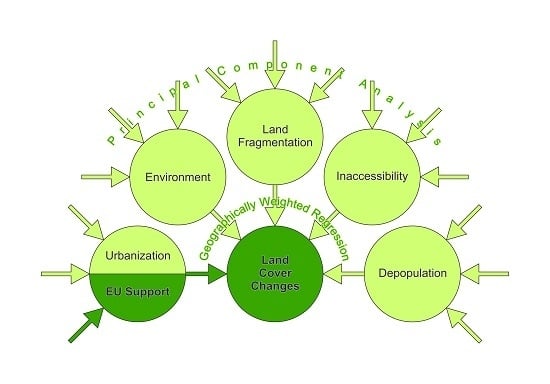The Impact of EU Grants Absorption on Land Cover Changes—The Case of Poland
Abstract
1. Introduction
2. Literature Review
3. Methodological Framework
3.1. Research Area
3.2. Data Collection
3.3. Methods of Analysis
4. Results
4.1. Hot Spots and Cold Spots of Land Cover Changes and EU Support
4.2. Determinants of Land Cover Changes
4.3. Global and Local Models of Land Cover Changes
5. Discussion
6. Conclusions
Author Contributions
Funding
Acknowledgments
Conflicts of Interest
References
- Wang, J.; Lin, Y.; Glendinning, A.; Xu, Y. Land-use changes and land policies evolution in China’s urbanization processes. Land Use Policy 2018, 75, 375–387. [Google Scholar] [CrossRef]
- Schulp, C.J.E.; Levers, C.; Kuemmerle, T.; Tieskens, K.F.; Verburg, P.H. Mapping and modelling past and future land use change in Europe’s cultural landscapes. Land Use Policy 2019, 80, 332–344. [Google Scholar] [CrossRef]
- Cegielska, K.; Noszczyk, T.; Kukulska, A.; Szylar, M.; Hernik, J.; Dixon-Gough, R.; Jombach, S.; Valánszki, I.; Filepné Kovács, K. Land use and land cover changes in post-socialist countries: Some observations from Hungary and Poland. Land Use Policy 2018, 78, 1–18. [Google Scholar] [CrossRef]
- Fiedeń, Ł. Changes in land use in the communes crossed by the A4 motorway in Poland. Land Use Policy 2019, 85, 397–406. [Google Scholar] [CrossRef]
- Ikiel, C.; Dutucu, A.; Ustaoglu, B.; Kilic, D. Land use and land cover (LULC) classification using Spot-5 image in the Adapazari plain and its surroundings, Turkey. TOJSAT—Online J. Sci. Technol. 2012, 2, 37–42. [Google Scholar]
- Iverson, L.R. Land-use changes in Illinois, USA: The influence of landscape attributes on current and historic land use. Landsc. Ecol. 1988, 2, 45–61. [Google Scholar] [CrossRef]
- Nalej, M. Agricultural land cover changes in metropolitan areas of Poland for the period 1990–2012. Misc. Geogr. 2016, 20, 39–45. [Google Scholar] [CrossRef][Green Version]
- Schaffert, M.; Steensen, T. Land Cover Changes in Northern Germany Between 1990 and 2000—An East-West Perspective. A study based on CORINE Land Cover data. In Land Ownership and Land Use Development: He Integration of Past, Present, and Future in Spatial Planning and Land Management Policies; Hepperle, E., Dixon-Goug, R., Mansberger, R., Paulsson, J., Hernik, J., Kalbro, T., Eds.; VDF Hochschulverlag AG: Zurich, Switzerland, 2017; pp. 157–169. [Google Scholar]
- Boucher, Y.; Grondin, P.; Auger, I. Land use history (1840–2005) and physiography as determinants of southern boreal forests. Landsc. Ecol. 2014, 29, 437–450. [Google Scholar] [CrossRef]
- Van Doorn, A.M.; Bakker, M.M. The destination of arable land in a marginal agricultural landscape in South Portugal: An exploration of land use change determinants. Landsc. Ecol. 2007, 22, 1073–1087. [Google Scholar] [CrossRef]
- Rutherford, G.N.; Guisan, A.; Zimmermann, N.E. Evaluating sampling strategies and logistic regression methods for modelling complex land cover changes. J. Appl. Ecol. 2007, 44, 414–424. [Google Scholar] [CrossRef]
- Prishchepov, A.A.; Müller, D.; Dubinin, M.; Baumann, M.; Radeloff, V.C. Determinants of agricultural land abandonment in post-Soviet European Russia. Land Use Policy 2013, 30, 873–884. [Google Scholar] [CrossRef]
- Stoebner, T.J.; Lant, C.L. Geographic determinants of rural land covers and the agricultural margin in the Central United States. Appl. Geogr. 2014, 55, 138–154. [Google Scholar] [CrossRef]
- Tu, J. Spatially varying relationships between land use and water quality across an urbanization gradient explored by geographically weighted regression. Appl. Geogr. 2011, 31, 376–392. [Google Scholar] [CrossRef]
- Badinger, H.; Müller, W.G.; Tondl, G. Regional convergence in the European Union 1985–1999: A spatial dynamic panel analysis. Reg. Stud. 2004, 38, 241–253. [Google Scholar] [CrossRef]
- Dall’erba, S.; Le Gallo, J. Regional convergence and the impact of European structural funds over 1989–1999: A spatial econometric analysis. Pap. Reg. Sci. 2008, 82, 219–244. [Google Scholar] [CrossRef]
- Lolos, S.E.G. The effect of EU structural funds on regional growth: Assessing the evidence from Greece, 1990–2005. Econ. Chang. Restruct. 2009, 42, 211–228. [Google Scholar] [CrossRef]
- Percoco, M. The Impact of Structural Funds on the Italian Mezzogiorno, 1994–1999. Reg. Dev. 2005, 21, 141–152. [Google Scholar]
- Mohl, P.; Hagen, T. Do EU structural funds promote regional growth? New evidence from various panel data approaches. Reg. Sci. Urban Econ. 2010, 40, 353–365. [Google Scholar] [CrossRef]
- Churski, P. Structural funds of the European Union in Poland—Experience of the first period of membership. Eur. Plan. Stud. 2008, 16, 579–607. [Google Scholar] [CrossRef]
- Dąbrowski, M. Structural funds as a driver for institutional change in Poland. Eur. Asia Stud. 2008, 60, 227–248. [Google Scholar] [CrossRef]
- Kasza, A. Two Ends of a Stick? Regional Strategic Planning and Operational Programming in Poland in the Context of EU Membership. Reg. Stud. 2009, 43, 625–636. [Google Scholar] [CrossRef]
- Lewandowska, A.; Stopa, M.; Humenny, G. The European Union Structural Funds and Regional Development. The Perspective of Small and Medium Enterprises in Eastern Poland. Eur. Plan. Stud. 2015, 23, 758–797. [Google Scholar] [CrossRef]
- Štreimikiene, D. Review of financial support from EU Structural Funds to sustainable energy in Baltic States. Renew. Sustain. Energy Rev. 2016, 58, 1027–1038. [Google Scholar] [CrossRef]
- Chakir, R.; Parent, O. Determinants of land use changes: A spatial multinomial probit approach. Pap. Reg. Sci. 2009, 88, 327–344. [Google Scholar] [CrossRef]
- Zoppi, C.; Lai, S. Determinants of land take at the regional scale: A study concerning Sardinia (Italy). Environ. Impact Assess. Rev. 2015, 55, 1–10. [Google Scholar] [CrossRef]
- Li, L.; Wang, Y. Land Use/Cover Change from 2001 to 2010 and its Socioeconomic Determinants in Guangdong Province, A Rapid Urbanization Area of China. J. Agric. Sci. 2016, 22, 275–294. [Google Scholar]
- Feranec, J.; Šuri, M.; Ot’ahel’, J.; Cebecauer, T.; Kolář, J.; Soukup, T.; Zdeňková, D.; Waszmuth, J.; Vâjdea, V.; Vîjdea, A.M.; et al. Inventory of major landscape changes in the Czech Republic, Hungary, Romania and Slovak Republic 1970s–1990s. ITC J. 2000, 2, 129–139. [Google Scholar] [CrossRef]
- Borowska-Stefańska, M.; Leśniewska-Napierała, K.; Wiśniewski, S. Land cover changes in Poland between 1990 and 2012. Geografie 2018, 123, 63–83. [Google Scholar]
- Bonilla-Moheno, M.; Aide, T.M.; Clark, M.L. The influence of socioeconomic, environmental, and demographic factors on municipality-scale land-cover change in Mexico. Reg. Environ. Chang. 2012, 12, 453–557. [Google Scholar] [CrossRef]
- Aguiar, A.P.D.; Câmara, G.; Escada, M.I.S. Spatial statistical analysis of land-use determinants in the Brazilian Amazonia: Exploring intra-regional heterogeneity. Ecol. Modell. 2007, 209, 169–188. [Google Scholar] [CrossRef]
- Ariti, A.T.; van Vliet, J.; Verburg, P.H. Land-use and land-cover changes in the Central Rift Valley of Ethiopia: Assessment of perception and adaptation of stakeholders. Appl. Geogr. 2015, 65, 28–37. [Google Scholar] [CrossRef]
- Lambin, E.F.; Turner, B.L.; Geist, H.J.; Agbola, S.B.; Angelsen, A.; Bruce, J.W.; Coomes, O.T.; Dirzo, R.; Fischer, G.; Folke, C.; et al. The causes of land-use and land-cover change: Moving beyond the myths. Glob. Environ. Chang. 2001, 11, 161–269. [Google Scholar] [CrossRef]
- Wu, C.; Wei, Y.D.; Huang, X.; Chen, B. Economic transition, spatial development and urban land use efficiency in the Yangtze River Delta, China. Habitat Int. 2017, 63, 67–78. [Google Scholar] [CrossRef]
- Alphan, H. Land-use change and urbanization of Adana, Turkey. Land Degrad. Dev. 2003, 14, 575–586. [Google Scholar] [CrossRef]
- Dannenberg, P.; Kuemmerle, T. Farm Size and Land Use Pattern Changes in Postsocialist Poland. Prof. Geogr. 2010, 62, 197–210. [Google Scholar] [CrossRef]
- Łowicki, D.; Mizgajski, A. Typology of physical-geographical regions in Poland in line with land-cover structure and its changes in the years 1990–2006. Geogr. Pol. 2013, 86, 255–266. [Google Scholar] [CrossRef]
- Noszczyk, T. Land use change monitoring as a task of local government administration in Poland. J. Ecol. Eng. 2018, 19, 170–176. [Google Scholar] [CrossRef]
- Woch, F. Ocena zmian wykorzystania przestrzeni wiejskiej w Polsce. Pol. J. Agron. 2014, 18, 52–62. [Google Scholar]
- Ciołkosz, A.; Poławski, Z. Zmiany użytkowania ziemi w Polsce w II połowie XX wieku na podstawie analizy danych kartograficznych. Rocz. Geomatyki Ann. Geomat. 2005, 3, 17–26. [Google Scholar]
- Woch, F.; Woch, R. Zmiany użytkowania przestrzeni wiejskiej w Polsce. Infrastruct. Ecol. Rural Areas 2014, 1, 111–124. [Google Scholar]
- Matyka, M. Analiza regionalnego zróżnicowania zmian w użytkowaniu gruntów w Polsce. Pol. J. Agron. 2012, 10, 16–20. [Google Scholar]
- Kurowska, K.; Rudnicki, R. Changes in land use in Poland—Comparative study of period 2002–2010. In Proceedings of the 7th International Scientific Conference Rural Development 2015, Kaunas, Lithuania, 19–20 November 2015; Raupeliene, A., Ed.; Aleksandras Stulginskis University: Kaunas, Lithuania, 2015. [Google Scholar]
- Tokarczyk-Dorociak, K.; Kazak, J.; Szewrański, S. The impact of a large city on land use in suburban area—The case of Wrocław (Poland). J. Ecol. Eng. 2018, 19, 89–98. [Google Scholar] [CrossRef]
- Łowicki, D. Land use changes in Poland during transformation. Case study of Wielkopolska region. Landsc. Urban Plan. 2008, 87, 279–288. [Google Scholar] [CrossRef]
- Bergeron, G.; Pender, J. Determinants of Land Use Change: Evidence from a Community Study in Honduras; Discussion Paper; EPTD: Washington, DC, USA, 1999; No. 46. [Google Scholar]
- Braimoh, A.K.; Onishi, T. Spatial determinants of urban land use change in Lagos, Nigeria. Land Use Policy 2007, 24, 502–515. [Google Scholar] [CrossRef]
- Su, S.; Xiao, R.; Zhang, Y. Multi-scale analysis of spatially varying relationships between agricultural landscape patterns and urbanization using geographically weighted regression. Appl. Geogr. 2012, 32, 360–375. [Google Scholar] [CrossRef]
- Wear, D.N.; Bolstad, P. Land-use changes in Southern Appalachian landscapes: Spatial analysis and forecast evaluation. Ecosystems 1998, 1, 575–594. [Google Scholar] [CrossRef]
- Verburg, P.H.; Ritsema van Eck, J.R.; de Nijs, T.C.M.; Dijst, M.J.; Schot, P. Determinants of land-use change patterns in the Netherlands. Environ. Plan. B Plan. Des. 2004, 31, 125–150. [Google Scholar] [CrossRef]
- Bamwerinde, W.; Bashaasha, B.; Ssembajjwe, W.; Place, F. Determinants of Land Use in the Densely Populated Kigezi Highlands of Southern Uganda; 2006; Available online: https://core.ac.uk/download/pdf/6653411.pdf (accessed on 20 August 2019).
- Handavu, F.; Chirwa, P.W.C.; Syampungani, S. Socio-economic factors influencing land-use and land-cover changes in the miombo woodlands of the Copperbelt province in Zambia. For. Policy Econ. 2019, 100, 75–94. [Google Scholar] [CrossRef]
- Nguyen, T.T.; Nguyen, L.D.; Lippe, R.S.; Grote, U. Determinants of Farmers’ Land Use Decision-Making: Comparative Evidence from Thailand and Vietnam. World Dev. 2017, 89, 199–213. [Google Scholar] [CrossRef]
- Nguyen, S.T. Determinants of land-use change: A case study from the lower Mekong delta of southern Vietnam. Electron. Green J. 2008, 1, 1–12. [Google Scholar]
- Bański, J. Koncepcje rozwoju struktury przestrzennej w Polsce—Polaryzacja czy równoważenie? Prz. Geogr. 2007, 79, 45–77. [Google Scholar]
- Gorzelak, G. Regional and Local Potential for Transformation in Poland; European Institute for Regional and Local Development: Warsaw, Poland, 1998. [Google Scholar]
- Węcławowicz, G.; Bański, J.; Degórski, M.; Komornicki, T.; Korcelli, P.; Śleszyński, P. Przestrzenne Zagospodarowanie Polski na Początku XXI Wieku; IGiPZ PAN: Warsaw, Poland, 2006. [Google Scholar]
- Kowalski, T. Globalization and Transformation in Central European Countries: The Case of Poland; Poznań University of Economics: Poznań, Poland, 2013. [Google Scholar]
- Bański, J. The consequences of changes of ownership for agricultural land use in Central European countries following the collapse of the Eastern Bloc. Land Use Policy 2017, 66, 120–130. [Google Scholar] [CrossRef]
- Wendt, J.A. The administrative division of Poland and the prospects of the transborder cooperation. In Changing Role of Border Areas and Regional Policies, Region and Regionalism No. 5; Koter, M., Ed.; Wydawnictwo Uniwersytetu Łódzkiego: Łódź-Opole, Poland, 2001; pp. 39–48. [Google Scholar]
- Majewska, J. Inter-regional agglomeration effects in tourism in Poland. Tour. Geogr. 2015, 17, 408–436. [Google Scholar] [CrossRef]
- Majewska, J.; Napierała, T.; Adamiak, M. Wykorzystanie nowych technologii i informacji do opisu przestrzeni turystycznej. Folia Tur. 2016, 41, 309–339. [Google Scholar]
- Chojnicki, Z.; Czyż, T.; Parysek, J.J.; Ratajczak, W. Badania Przestrzennej Struktury Społeczno-Ekonomicznej Polski Metodami Czynnikowymi; Państwowe Wydawnictwo Naukowe: Warsaw, Poland, 1978. [Google Scholar]
- Dunteman, G.H. Principal Component Analysis; Sage Publications: Newburry Park, CA, USA, 1989. [Google Scholar]
- Jolliffe, I.T. Principal Component Analysis; Springer: New York, NY, USA, 2002. [Google Scholar]
- Cheng, L.; Bingyu, W. Principal Components Analysis; 2014; Available online: http://www.ccs.neu.edu/home/vip/teach/MLcourse/5_features_dimensions/lecture_notes/PCA/PCA.pdf (accessed on 18 August 2019).
- Brown, S.; Versace, V.L.; Laurenson, L.; Ierodiaconou, D.; Fawcett, J.; Salzman, S. Assessment of Spatiotemporal Varying Relationships between Rainfall, Land Cover and Surface Water Area Using Geographically Weighted Regression. Environ. Model. Assess. 2012, 17, 241–254. [Google Scholar] [CrossRef]
- Huang, J.; Huang, Y.; Pontius, R.G.; Zhang, Z. Geographically weighted regression to measure spatial variations in correlations between water pollution versus land use in a coastal watershed. Ocean Coast. Manag. 2015, 103, 14–24. [Google Scholar] [CrossRef]
- Li, C.; Li, F.; Wu, Z.; Cheng, J. Exploring spatially varying and scale-dependent relationships between soil contamination and landscape patterns using geographically weighted regression. Appl. Geogr. 2017, 82, 101–114. [Google Scholar] [CrossRef]
- Gao, J.; Li, S. Detecting spatially non-stationary and scale-dependent relationships between urban landscape fragmentation and related factors using Geographically Weighted Regression. Appl. Geogr. 2011, 31, 292–302. [Google Scholar] [CrossRef]
- Taghipour Javi, S.; Malekmohammadi, B.; Mokhtari, H. Application of geographically weighted regression model to analysis of spatiotemporal varying relationships between groundwater quantity and land use changes (case study: Khanmirza Plain, Iran). Environ. Monit. Assess. 2014, 186, 3123–3138. [Google Scholar] [CrossRef]
- Matthews, S.A.; Yang, T.C. Mapping the results of local statistics: Using geographically weighted regression. Demogr. Res. 2012, 26, 151–166. [Google Scholar] [CrossRef]
- Mennis, J. Mapping the results of geographically weighted regression. Cartogr. J. 2006, 43, 171–179. [Google Scholar] [CrossRef]
- Pineda Jaimes, N.B.; Bosque Sendra, J.; Gómez Delgado, M.; Franco Plata, R. Exploring the driving forces behind deforestation in the state of Mexico (Mexico) using geographically weighted regression. Appl. Geogr. 2010, 30, 576–591. [Google Scholar] [CrossRef]
- Charlton, M.; Fotheringam, S. Geographically Weighted Regression. A Tutorial on Using GWR in ArcGIS 9.3; National Centre for Geocomputation National University of Ireland Maynooth: Maynooth, Ireland, 2009. [Google Scholar]
- Shariff, N.M.; Gairola, S.; Talib, A. Modelling urban land use change using geographically weighted regression and the implications for sustainable environmental planning. In Proceedings of the Modelling for Environment’s Sake: 5th Biennial Conference of the International Environmental Modelling and Software Society, iEMSs 2010, Ottawa, ON, Canada, 5–8 July 2010. [Google Scholar]
- Wrenn, D.H.; Sam, A.G. Geographically and temporally weighted likelihood regression: Exploring the spatiotemporal determinants of land use change. Reg. Sci. Urban Econ. 2014, 44, 60–74. [Google Scholar] [CrossRef]
- Demetriou, D.; Suntilwell, J.; See, L. A new methodology for measuring land fragmentation. Comput. Environ. Urban Syst. 2013, 39, 71–80. [Google Scholar] [CrossRef]
- Borowska-Stefańska, M.; Leśniewska-Napierała, K.; Wiśniewski, S. Spatial variation in size and shape of land plots in Mazowieckie voivodship. Eur. Spat. Res. Policy 2018, 25, 113–130. [Google Scholar] [CrossRef]
- Pierri Daunt, A.B.; Sanna Freire Silva, T. Beyond the park and city dichotomy: Land use and land cover change in the northern coast of São Paulo (Brazil). Landsc. Urban Plan. 2019, 189, 352–361. [Google Scholar] [CrossRef]
- Asadi, A.; Barati, A.A.; Kalantari, K.; Odeh, I. Study of relationship between roads network development and agricultural land conversion in Iran NorthWest. Int. J. Environ. Res. 2016, 10, 51–58. [Google Scholar]
- Villarroya, A.; Puig, J. Urban and industrial land-use changes alongside motorways within the Pyrenean area of Navarre, Spain. Environ. Eng. Manag. J. 2012, 11, 1213–1220. [Google Scholar]
- Xu, Y. Rethinking the politics of land-use change: Insights from the rise of the industrial tree plantation sector in Southern China. Land Use Policy 2019, 87, 1–10. [Google Scholar] [CrossRef]
- Martinuzzi, S.; Gould, W.A.; Ramos González, O.M. Land development, land use, and urban sprawl in Puerto Rico integrating remote sensing and population census data. Landsc. Urban Plan. 2007, 79, 288–297. [Google Scholar] [CrossRef]
- Oueslati, W.; Alvanides, S.; Garrod, G. Determinants of urban sprawl in European cities. Urban Stud. 2015, 52, 1594–1614. [Google Scholar] [CrossRef] [PubMed]
- Yu, J.; Zhou, K.; Yang, S. Land use efficiency and influencing factors of urban agglomerations in China. Land Use Policy 2019, 88, 104143. [Google Scholar] [CrossRef]
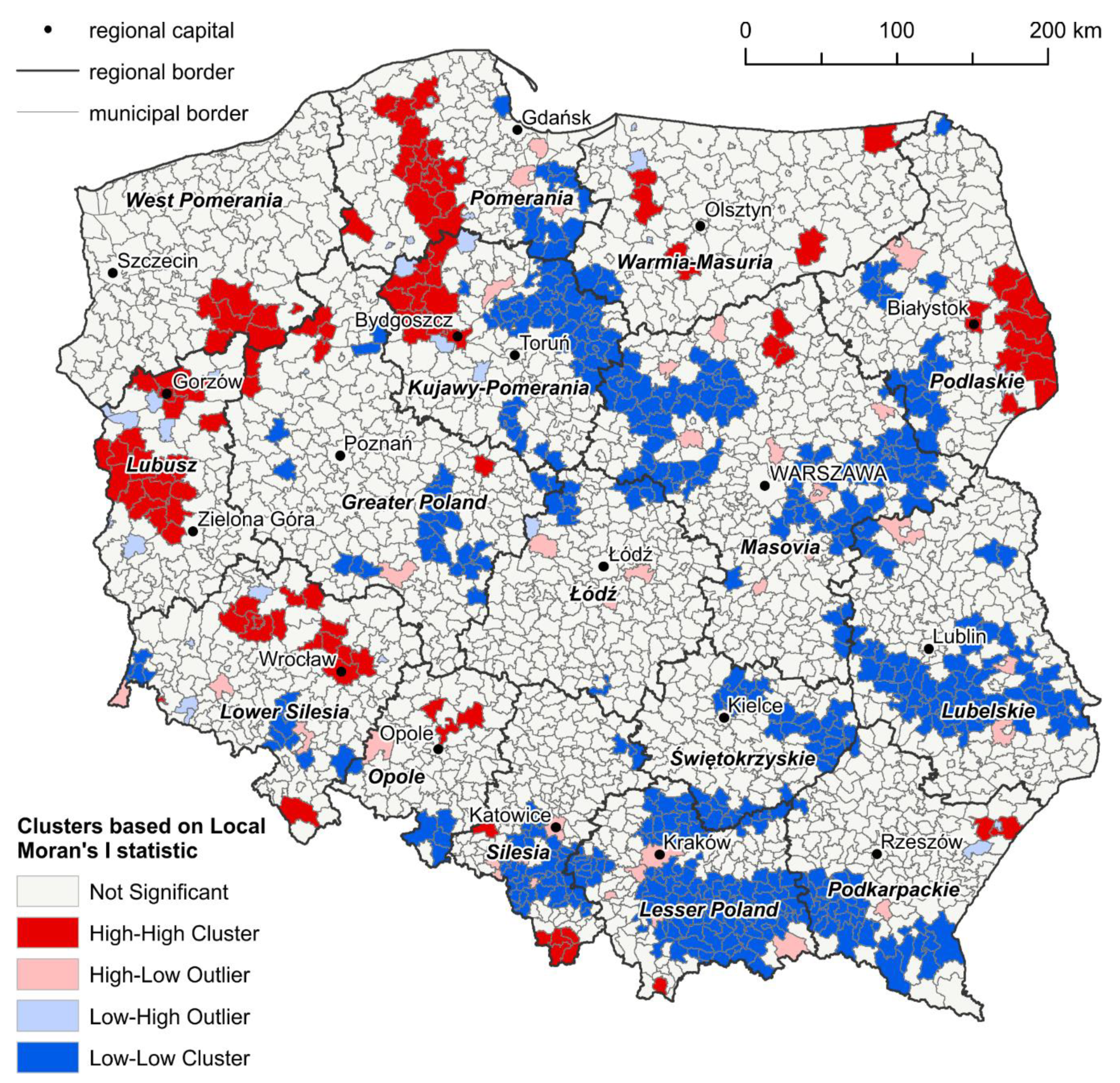
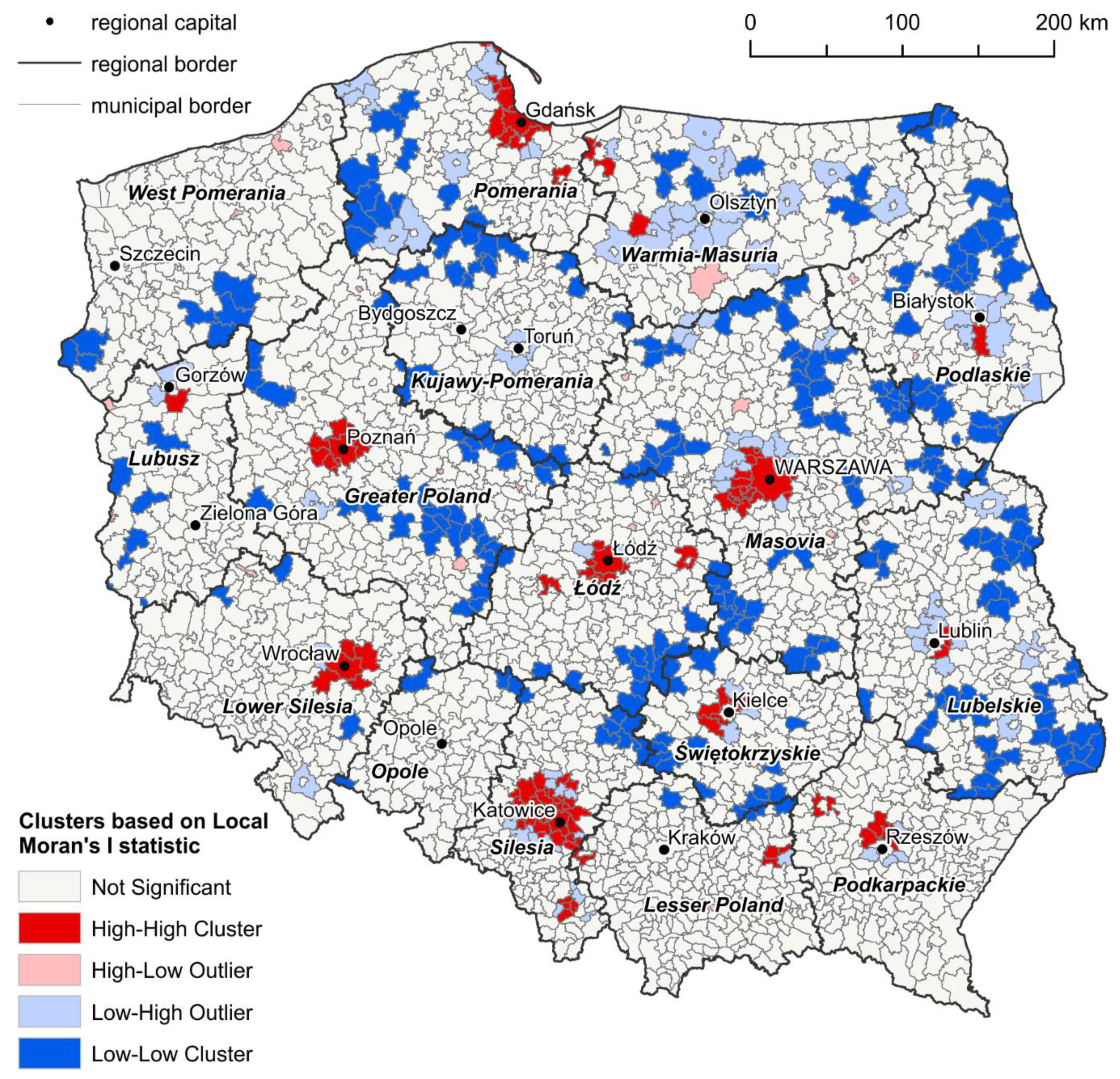
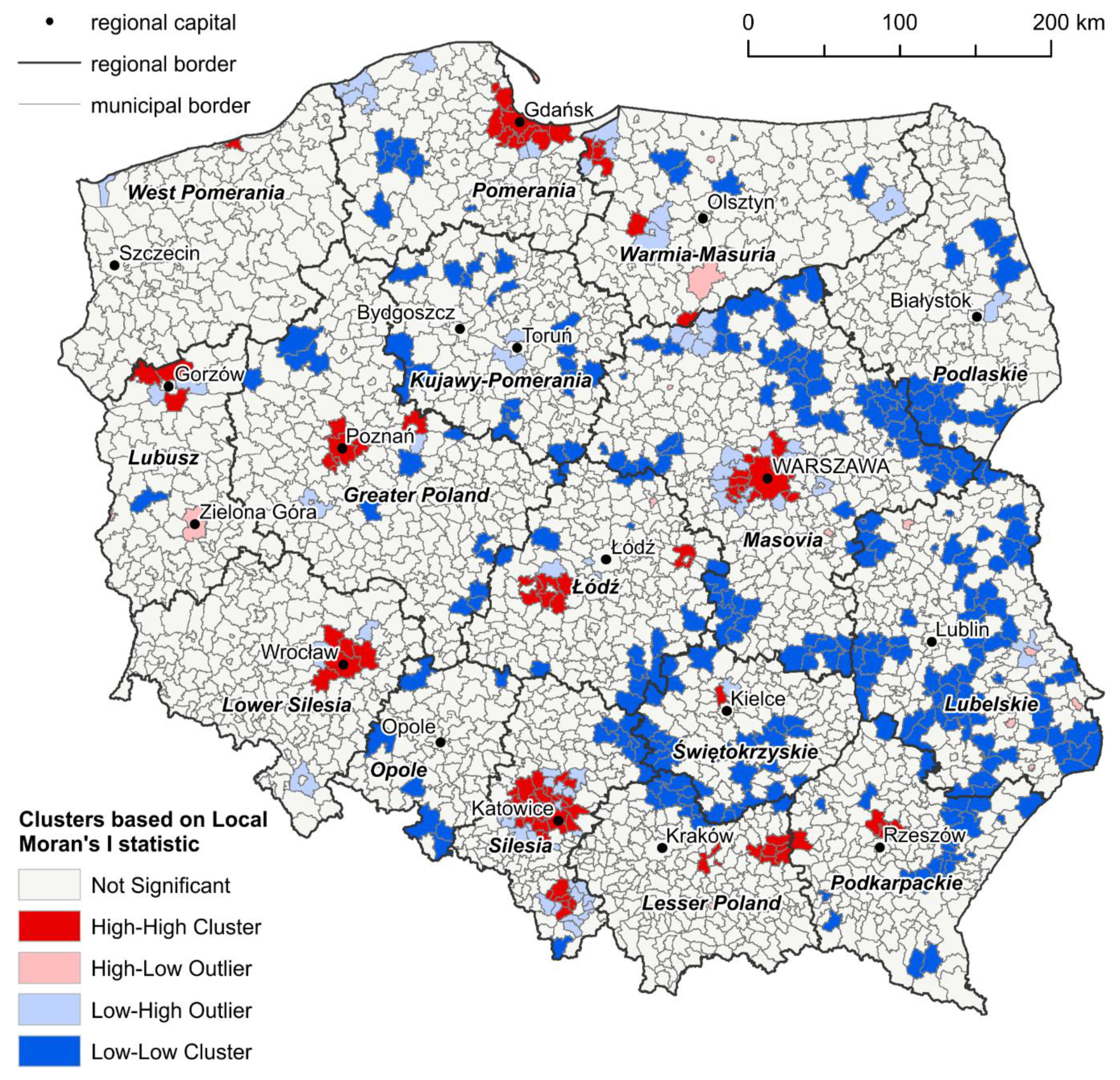

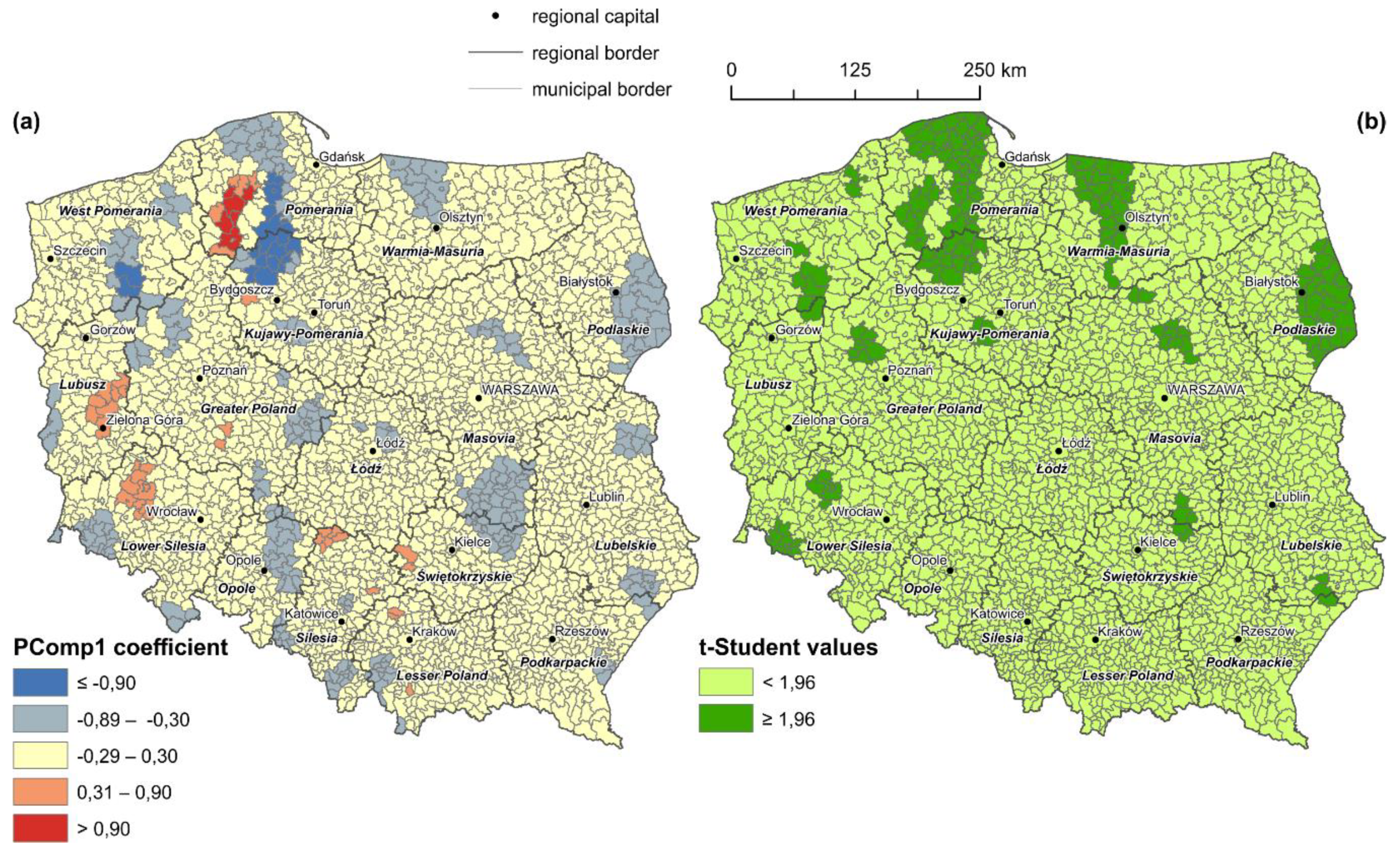
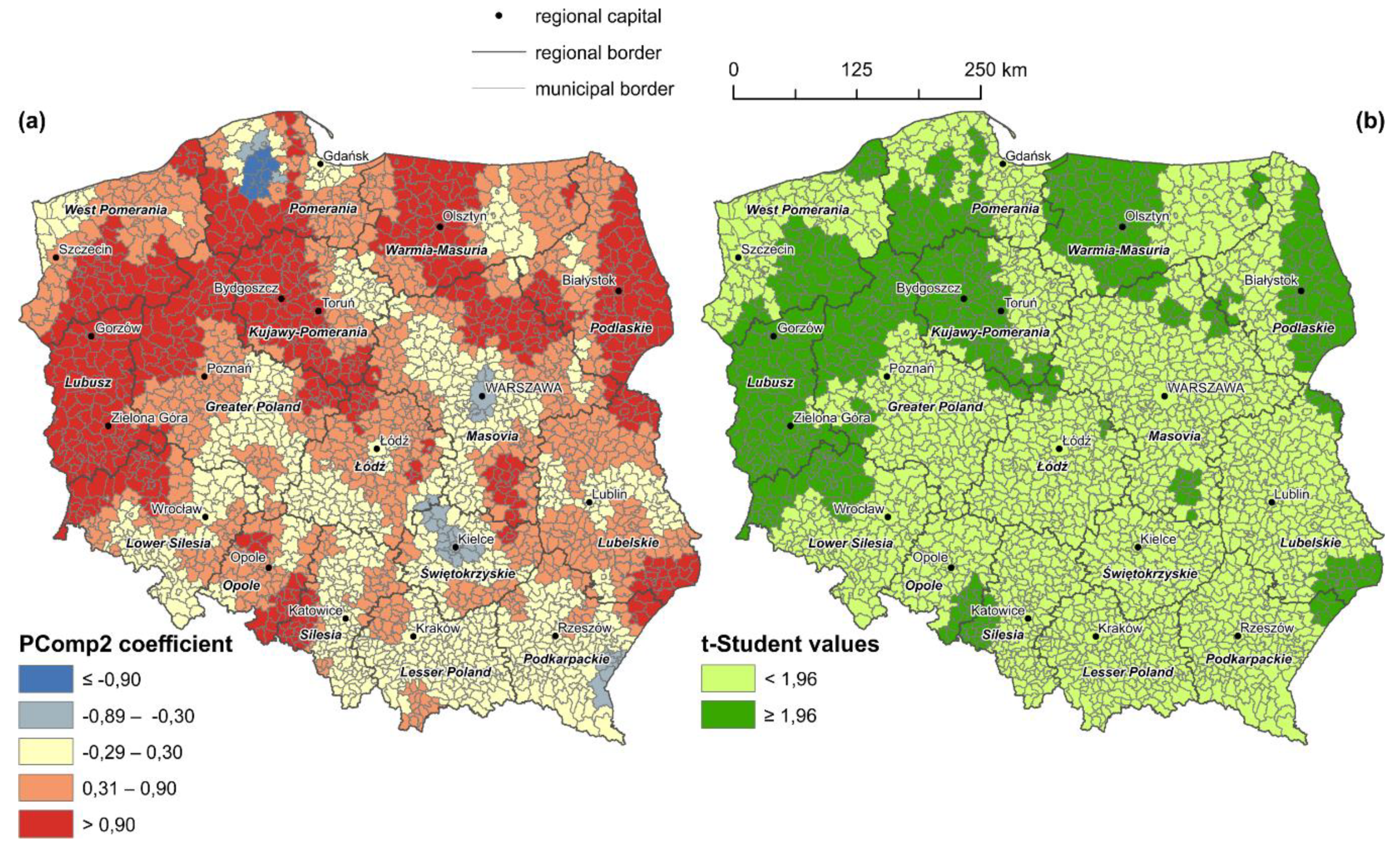
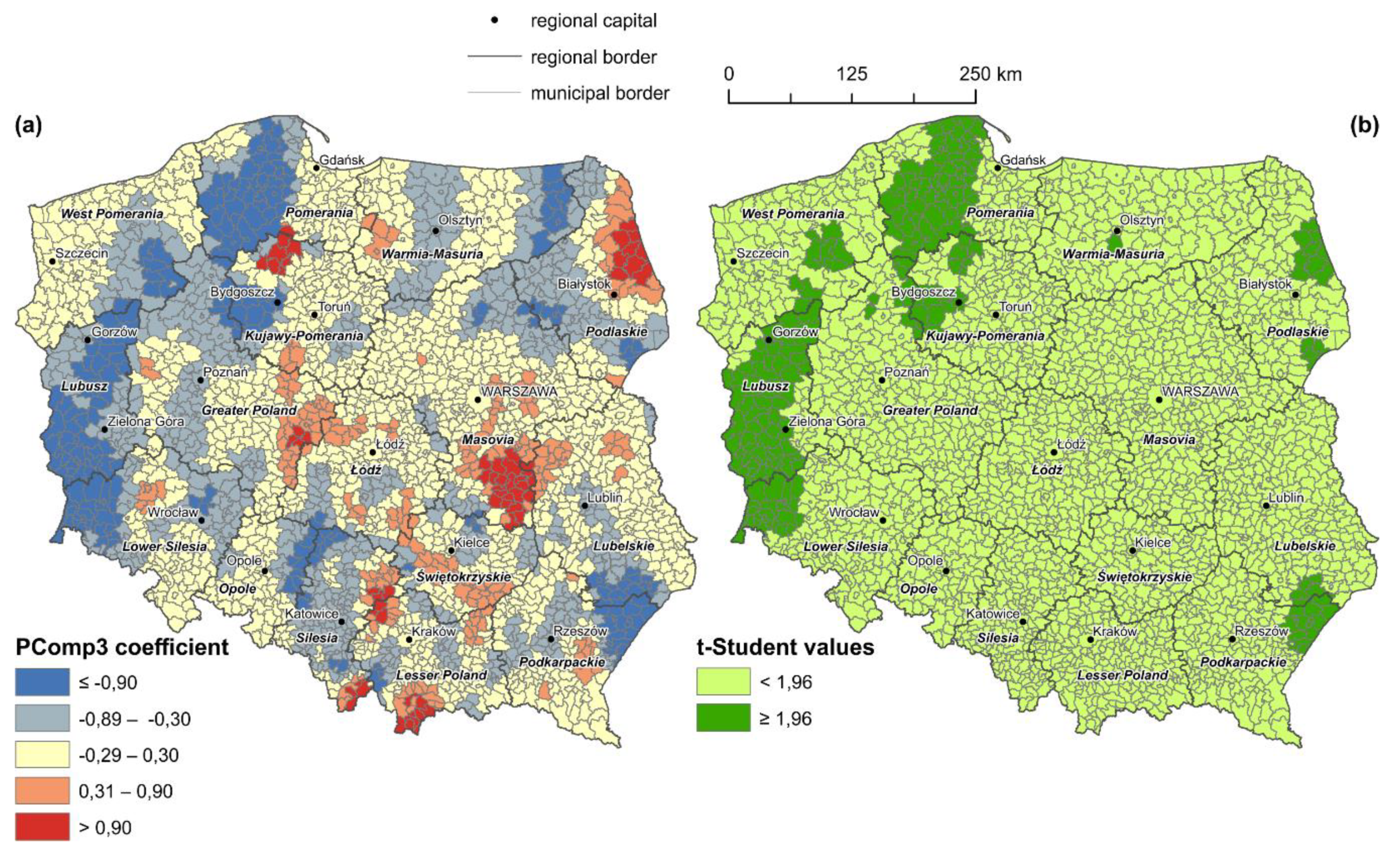
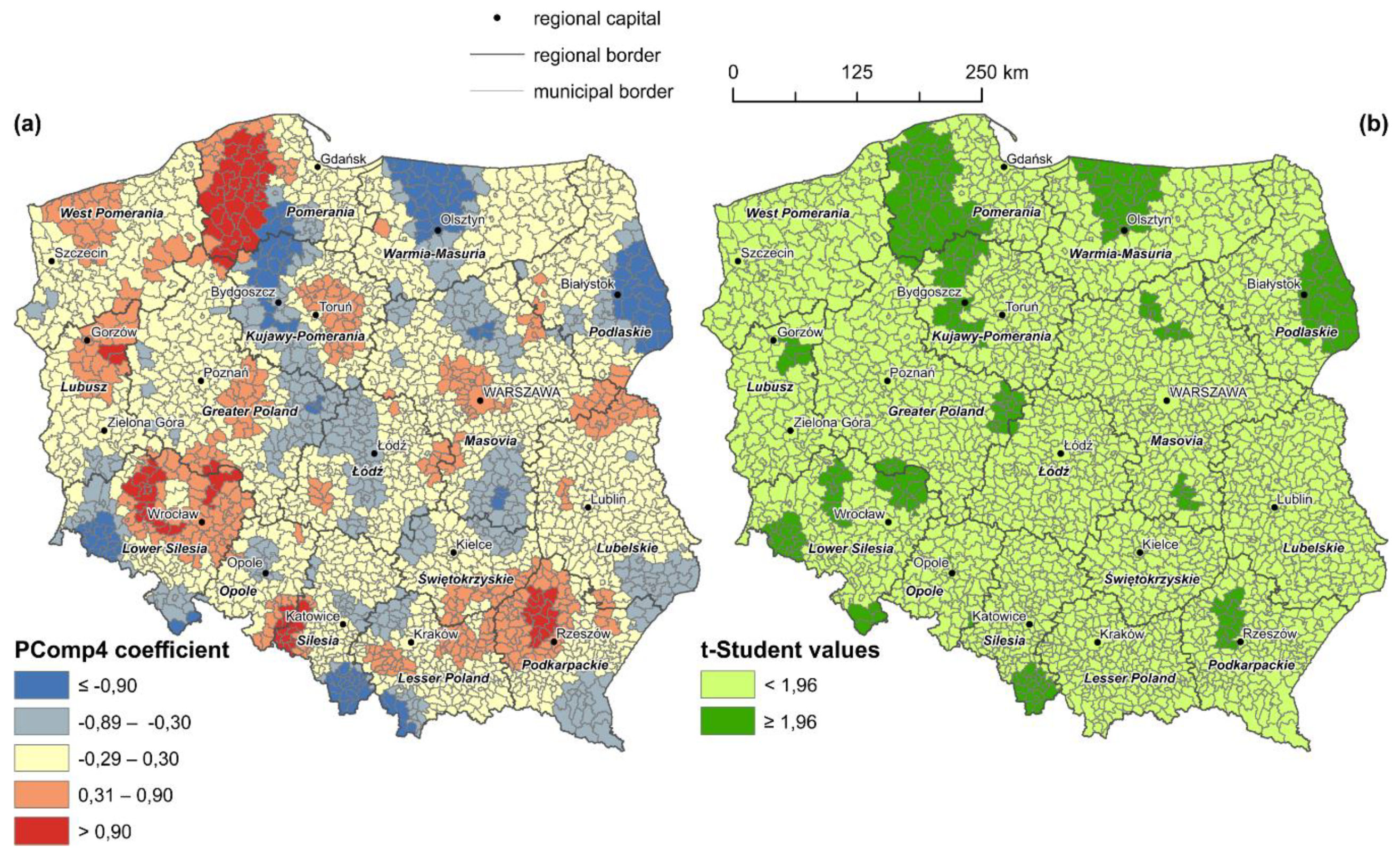
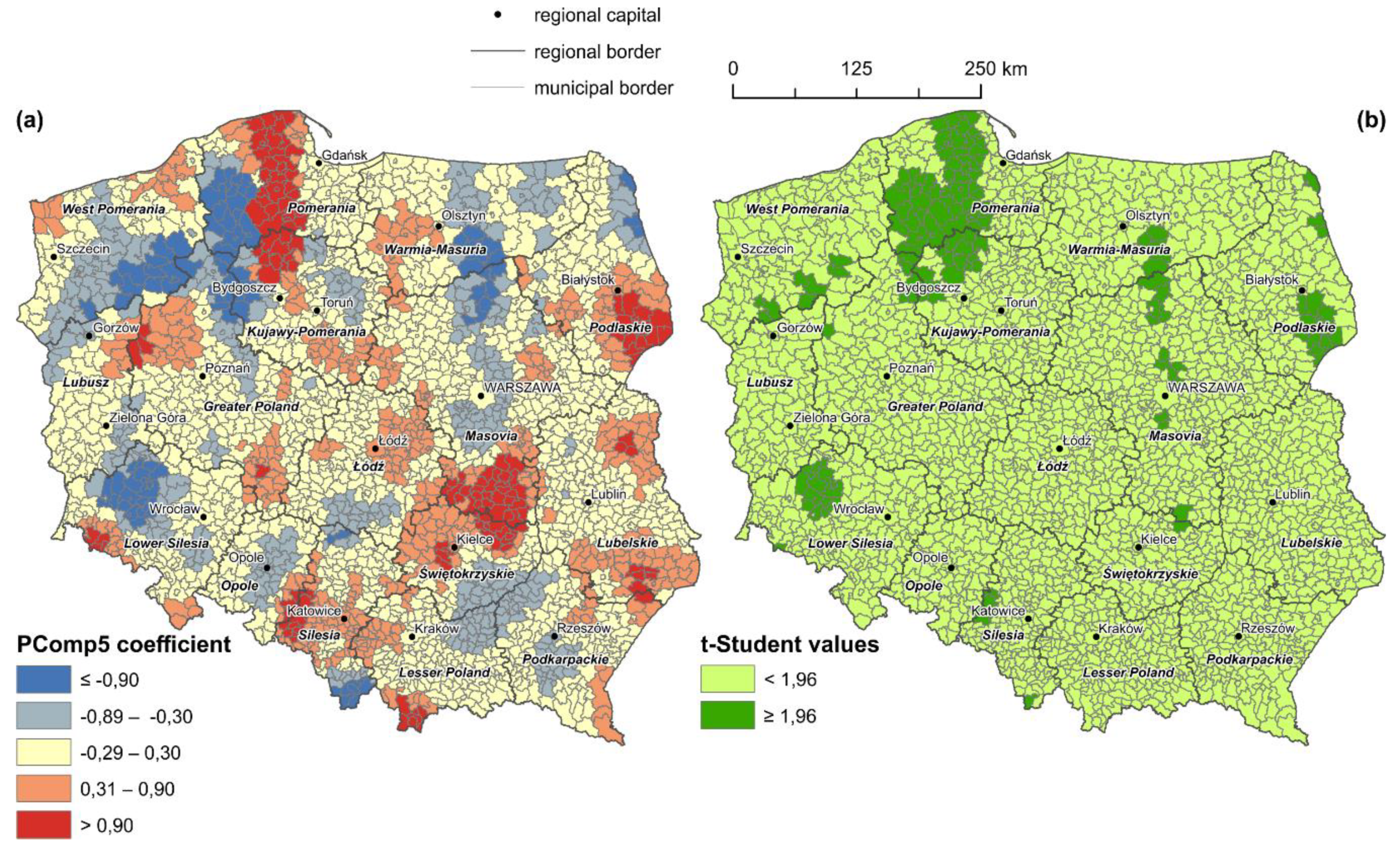
| Variable | Abbreviation | Data Source for This Research | Measure [Unit] | Research Where the Variable Was Considered Before |
|---|---|---|---|---|
| Density of roads | DENSROADS | Head Office of Geodesy and Cartography | Density of roads [km/km2] | [12] |
| Distance from the main roads | DISTMROAD | Head Office of Geodesy and Cartography | Distance to the closest main road [km] | [25,31,46,47,48,49] |
| Distance from the nearest airport/seaport | DISTPORT | Head Office of Geodesy and Cartography | Distance to the closest airport/seaport [km] | [47,50] |
| Distance from the nearest railway station | DISTRAIL | Head Office of Geodesy and Cartography | Distance to the closest railway station [km] | [50] |
| Distance to the closest major urban centre | DISTCITY | Head Office of Geodesy and Cartography | Distance to the closest centroid of capital of a region [km] | [12,13,25,31,48,49,50] |
| Farm size | AVFARM | Statistics Poland | Average farm size [ha] | [10,46,51,52] |
| Type of breeding | DENSBREEIX | Statistics Poland | Index of breeding [index/km2] | [10,46] |
| Demography | Changes in population potential [POPCHANGE] | Statistics Poland | Relative population change between 2012 and 2018 [%] | [25,47] |
| Population density | POPDENSITY | Statistics Poland | Density of population [number/km2] | [12,25,31,52] |
| Absorption of EU funds | EU1218ALL; EU1218INFR | Statistics Poland | Sum of EU support from 2012 until 2018 [PLN/km2]; Sum of EU support under the Operational Programme “Infrastructure and Environment” from 2012 until 2018 [PLN/km2] | Own proposal |
| Income | MUNICINC | Statistics Poland | Municipal income [PLN/km2] | [25,52,53] |
| Number of enterprises | DENSENTERP | Statistics Poland | Density of enterprises [number/km2] | [54] |
| Landform | SLOPE | Head Office of Geodesy and Cartography | Average slope [deg.] | [25,46,47,49] |
| Precipitation and humidity | RAIN | Institute of Meteorology and Water Management | Annual average precipitation [mm] | [13,25,31] |
| Density of buildings | DENSBUILD | Head Office of Geodesy and Cartography | Density of buildings [number/km2] | [49] |
| Protected areas | SHAREPROTEC | Statistics Poland | Protected areas [% of municipal area] | [13,31] |
| Size of plots | AVPLOT | Head Office of Geodesy and Cartography | Average plot size [m2] | [46,54] |
| Abbreviation of Investigated Determinant | Principal Component 1 [Urbanization and EU Support] | Principal Component 2 [Environment] | Principal Component 3 [Land Fragmentation] | Principal Component 4 [Inaccessibility] | Principal Component 5 [Depopulation] |
|---|---|---|---|---|---|
| DENSROADS | 0.295 | −0.265 | 0.139 | −0.112 | 0.077 |
| DISTMROAD | −0.107 | −0.040 | −0.017 | −0.229 | −0.378 |
| DISTPORT | −0.118 | −0.189 | 0.118 | −0.438 | −0.206 |
| DISTRAIL | −0.158 | −0.072 | −0.056 | −0.450 | −0.299 |
| DISTCITY | −0.106 | −0.053 | −0.082 | −0.549 | 0.166 |
| AVFARM | −0.090 | −0.104 | −0.641 | −0.061 | 0.216 |
| DENSBREEIX | −0.035 | −0.335 | −0.055 | −0.092 | −0.133 |
| POPCHANGE | 0.002 | 0.072 | −0.170 | 0.284 | −0.604 |
| POPDENSITY | 0.393 | 0.014 | −0.044 | −0.156 | 0.103 |
| EU1218ALL | 0.355 | 0.088 | −0.225 | −0.044 | −0.181 |
| EU1218INFR | 0.262 | 0.112 | −0.290 | 0.043 | −0.347 |
| MUNICINC | 0.394 | 0.039 | −0.104 | −0.137 | 0.014 |
| DENSENTERP | 0.390 | 0.043 | −0.113 | −0.128 | −0.002 |
| SLOPE | −0.080 | 0.544 | 0.015 | −0.200 | 0.074 |
| RAIN | 0.008 | 0.553 | 0.062 | −0.152 | 0.095 |
| DENSBUILD | 0.372 | −0.019 | 0.143 | −0.095 | 0.085 |
| SHAREPROTEC | −0.093 | 0.360 | 0.044 | −0.106 | −0.192 |
| Determinants of Land Cover Changes | Coefficients | Standard Errors | t-Values | p-Values |
|---|---|---|---|---|
| Intercept | 1.356 | 0.047 | 28.611 | p-value → 0 |
| Principal component 1 (urbanization and EU support) | −0.131 | 0.020 | −6.646 | p-value → 0 |
| Principal component 2 (environment) | 0.290 | 0.034 | 8.552 | p-value → 0 |
| Principal component 3 (land fragmentation) | −0.498 | 0.039 | −12.705 | p-value → 0 |
| Principal component 4 (inaccessibility) | 0.071 | 0.041 | 1.729 | 0.084 |
| Principal component 5 (depopulation) | 0.004 | 0.044 | 0.079 | 0.937 |
© 2019 by the authors. Licensee MDPI, Basel, Switzerland. This article is an open access article distributed under the terms and conditions of the Creative Commons Attribution (CC BY) license (http://creativecommons.org/licenses/by/4.0/).
Share and Cite
Leśniewska-Napierała, K.; Nalej, M.; Napierała, T. The Impact of EU Grants Absorption on Land Cover Changes—The Case of Poland. Remote Sens. 2019, 11, 2359. https://doi.org/10.3390/rs11202359
Leśniewska-Napierała K, Nalej M, Napierała T. The Impact of EU Grants Absorption on Land Cover Changes—The Case of Poland. Remote Sensing. 2019; 11(20):2359. https://doi.org/10.3390/rs11202359
Chicago/Turabian StyleLeśniewska-Napierała, Katarzyna, Marta Nalej, and Tomasz Napierała. 2019. "The Impact of EU Grants Absorption on Land Cover Changes—The Case of Poland" Remote Sensing 11, no. 20: 2359. https://doi.org/10.3390/rs11202359
APA StyleLeśniewska-Napierała, K., Nalej, M., & Napierała, T. (2019). The Impact of EU Grants Absorption on Land Cover Changes—The Case of Poland. Remote Sensing, 11(20), 2359. https://doi.org/10.3390/rs11202359






